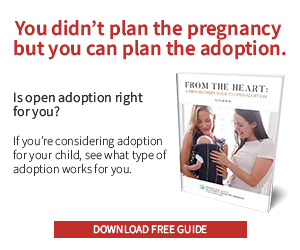Heartbreak and Healing in the Adoption Journey
As I walked into the metropolitan hospital that had been my home away from home for years, I often found myself thinking about the opposite ends of the spectrum most hospital visitors fell on. Some visitors were experiencing the beginning of life—the birth of a precious child, grandchild, or sibling. Others, however, were saying their final goodbyes to their loved ones. One experiencing the joys of the beginning of life, another experiencing the sadness and angst of the end of life. In some ways, adoption falls on a similar spectrum when you think about it. While one woman is facing potentially one of the hardest days of her life as she leaves the hospital without the baby she has carried the last nine months, another is perhaps becoming a mother for the first time as a result of this decision.
Adoption is often considered as a triad constructed of the adoptee (child who was adopted), the adoptive family, and the first family or birth family. When you think of the journey of heartbreak and healing, each member of the triad has their own unique journey that, although similar, is also very, very different and likely to occur at different times than the other members of the triad.
The Birth Mother’s Journey
Not all women who place their children for adoption are the same, so it is unfair to think that their journey from heartbreak to healing would be the same either. However, there are likely some overlapping themes throughout many of their stories. Although she has made the choice to place her baby with a family outside of her own, this decision doesn’t make the execution of it easier. Although she may be at peace with her decision, it takes time for a heart to mend or the pain to subside. The immediate love a mother feels for her child the moment that baby is laid onto her chest is one of the most strong emotions I know. I would imagine that the moment this part of the birth mother’s and baby’s story ends is when the apex of the birth mother’s heartbreak is felt—the moment of saying “Goodbye,” or “See you later.” As her milk comes in, her period returns, and/or her pre-pregnancy clothes begin to fit again are all other moments that are likely painful and sometimes cruel reminders that, although she did choose the life she wanted for her child, she did not bring home a baby. Her journey to healing is dependent on many factors.
One of the most important indicators of how this journey will go for a person is their resilience. Sheryl Sandberg is the Chief Operating Officer (COO) of Facebook whose husband very suddenly and unexpectedly passed away at the age of 47. She defines resilience as “the strength and speed of our response to adversity.” The ability to recognize a situation as the worst pain we have ever experienced while also recognizing that we will not feel this intensity of grief or pain forever is the picture of resilience.

Another incredibly important factor in the journey from heartbreak to healing will be how well supported the birth mother is or feels. If she is surrounded by family and/or friends who love her and give her the space she deserves to feel how she feels (sad, angry, at peace, optimistic, rinse, and repeat) and listen to her as she processes these feelings, she will likely find herself moving in a direction towards healing. If she is surrounded by people who are either cruel or superficial, this journey will be more difficult. Often, a person doesn’t need a ton of people who support them, but knowing they have one or two people who are always in their corner and will always be there for them is huge and could make a huge difference in how quickly one heals.
The relationship a birth mother has with her child’s adoptive family can also greatly affect her journey from heartbreak to healing. If she was promised a very open situation that is not honored once the ink dried on the adoption proceedings, her heartbreak may persist—and now on a whole new level. However, if she has an open relationship with her child’s adoptive family that makes her feel like a valued, loved part of the adoption triad, and because of this relationship, she is able to see that her child is loved and thriving, her journey to healing is likely much more accessible.
Although these are likely factors that affect a birth family’s (specifically a birth mother’s) journey from heartbreak to healing, they make the assumption that the heartbreak exists as a result of not parenting her child. The journey from heartbreak to healing may look different based on the actual root cause of her heartbreak, but will likely be affected by similar variables.
The Adoptive Parents’ Journey
There are actually several places that the adoptive parents may experience heartbreak. The empathy I felt for our daughter’s birth mother was like nothing I ever expected to experience. It took nearly a year for me to be able to talk about her without shedding tears. I often said “I didn’t expect to have any problem loving my baby, but I absolutely didn’t expect to absolutely fall in love with her first mother too.” My heart broke FOR her. My heart broke WITH her. Over the course of the first year of our open adoption, we slowly put those pieces back together, and what a beautiful journey that was. Another time I see the heartbreak of adoptive parents is a very different scenario—with international adoption. Many adoptive parents experience firsthand the discrimination against children with special needs in other countries. Their hearts break for their child’s first families that love these children but don’t live in a culture that allows them to take their babies home with them. Lastly, and the scenario most commonly thought of with adoptive parents, is often the heartbreak associated with infertility and the stressors of that process.
Pregnant and considering adoption?
Get your free adoption benefits and support bundle


As with first families, the journey to healing often varies depending on resilience, support, and the actual cause of the heartbreak to begin with. My own journey from heartbreak to healing, as an adoptive mother, was very much a result of the beautiful, and somewhat uncommon, relationship I have formed with my daughter’s first mother. We love her. We do life with her. I’m not constantly hoping she’s ok because I get to ask her, and hug her, and hang out with her. I know several adoptive families who have adopted children from Eastern Europe who had the rare opportunity to meet their children’s first families prior to returning to the US. They are able to share pictures and stories with their childrens’ first families. Several work in advocacy to help other countries have the resources and education needed to support families to bring home their special needs children. It is my hope that adoptive parents who are experiencing the end of their fertility journey will process their grief and their journey from heartbreak to healing PRIOR to starting their adoption process. Although it would seem that placing a baby in someone’s arms would fix their desire to become a parent, that is not always the case. It is not anyone else’s job to fix this heartbreak, and overall, the adoptive parents should be well on their journey to healing before they bring home a child through adoption.
The Adoptee’s Journey
Like their counterparts in the adoption triad, the experience of the adoptee along the journey from heartbreak to healing depends on so many factors. One of the main factors for the adoptee is the circumstances surrounding their adoption. For example, if they are adopted as a newborn, the heartbreak they experience is likely to occur later for them as they are old enough to understand some of their story. However, a 6-year-old child who is taken away from everything he or she knows, whether from an institution or orphanage setting in another country or from an unsafe or temporary home in this country, is still likely the only thing that child knows and leaving is scary and sad. Creating an environment of “felt safety,” a concept discussed by TBRI founder Karyn Purvis, helps the child not only BE safe, but also FEEL safe allowing them to learn, grow, and connect. Talking to children about how they feel and not telling them how they should feel is also very important as they vacillate along the continuum from heartbreak to healing. They need to be given the space to feel how they feel without having to worry about how their feelings make someone else feel. That’s a lot of feelings, right? In Creating Safe Places for Our Children, Karyn Puvis says “Children who feel safe can be released from emotions that have held them hostage. They are no longer prisoners of war; they are free to heal and to become secure, trusting children!” Experiencing healing and being secure and trusting children and adults is a destination we can all strive to reach along this journey from heartbreak to healing.
Many times, when people outside the inner adoption world hear the word “adoption,” they think of really positive words like forever, love, family, miracle, meant-to-be, and perfect. They are sometimes accused of looking through rose-colored glasses or embracing a rainbows-and-unicorns narrative. Although I know it is absolutely not all rainbows and unicorns, I do believe one can start their journey at heartbreak and find their way to healing. The rainbows and unicorns narrative can be detrimental to someone’s journey from heartbreak to healing because it doesn’t allow for processing real feelings—it only allows for the positive ones to be verbalized, and anger, hurt, and questioning are very valid feelings as well. Inevitably, the all-adoption-is-bad narrative is also equally harmful to one’s journey from heartbreak to healing. If an adoptee is exposed to this narrative, they may be encouraged to embrace the thought that there isn’t hope and beauty within their story and, as a result, feel stuck in heartbreak. It is incredibly hard to support portions of both narratives but also incredibly necessary to see both sides of this spectrum in order to support those you love along this journey from heartbreak to healing.

No matter where you find yourself on this journey, know that the journey itself is often the most important part. Ursula K. Le Guin accurately says, “It is good to have an end to journey toward; but it is the journey that matters, in the end.” If you find yourself stuck in a place of heartbreak, may you find a whole village of people who are ready and willing to sit with you in the dark or help you start your journey towards healing—depending on which you need. If this village doesn’t exist for you, do not hesitate to reach out to a counselor to help you during this heartbreak.
“The difference between winning and losing is most often not quitting.”—Walt Disney
No matter where you are on this journey, don’t quit. No matter how terrible the beginning of your story, it does not dictate the rest of your story—don’t quit. No matter how hard it seems—don’t quit. You are beautiful, and you can do this. Your journey is yours and isn’t subject to anyone else’s rules or expectations. May your journey write a beautiful story that when you look back, you know is beautifully yours—including the heartbreak and the healing.


